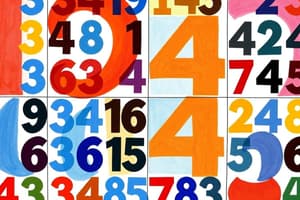Podcast
Questions and Answers
What are the origins of computers discussed in the text?
What are the origins of computers discussed in the text?
The origins of computers discussed in the text include Abacus, Napier's Bones, Slide Rule, Pascal's Calculator, Leibniz's Multiplication and Dividing Machine, Difference Engine, The Analytical Engine, Mechanical and Electrical Calculator, and Modern Electronic Calculator.
What are the different generations of computers mentioned in the text?
What are the different generations of computers mentioned in the text?
The different generations of computers mentioned in the text are: First Generation Computers (1940-1956), Second Generation Computers (1956-1963), Third Generation Computers (1964-1971), Fourth Generation Computers (1971-present), and Fifth Generation Computers (present-beyond).
What components are included in the computer system as per the text?
What components are included in the computer system as per the text?
The components included in the computer system as per the text are: How Computers Work, Operational Unit, System Unit, Von-Neumann Architecture, Classification of Computers, Classification by Technology, Integrated Circuits, and Electric Circuits.
What is the focus of the section on Computer Generations?
What is the focus of the section on Computer Generations?
What is the significance of the section on Computer System?
What is the significance of the section on Computer System?
Flashcards are hidden until you start studying
Study Notes
Origins of Computers
- The concept of computers dates back to ancient times, with the invention of the Abacus around 2500 BC
- Charles Babbage is credited with designing the first mechanical computer, the Analytical Engine, in the 19th century
Computer Generations
- The first generation (1940s-1950s) used vacuum tubes and was characterized by large size and high maintenance
- The second generation (1950s-1960s) used transistors, was smaller and more efficient, and introduced commercial computers
- The third generation (1960s-1980s) used integrated circuits, was more powerful, and introduced mini-computers
- The fourth generation (1980s-present) uses microprocessors, is highly efficient, and introduced personal computers
Computer System Components
- Input devices (e.g., keyboard, mouse)
- Central Processing Unit (CPU)
- Memory (RAM and ROM)
- Output devices (e.g., monitor, printer)
Focus of Computer Generations Section
- The section outlines the evolution of computers, highlighting the significant advancements and developments in each generation
Significance of Computer System Section
- The section explains the fundamental components of a computer system, emphasizing their role in processing, storing, and communicating information
Studying That Suits You
Use AI to generate personalized quizzes and flashcards to suit your learning preferences.




